Module 11 Unit 1说课稿
- 格式:doc
- 大小:40.50 KB
- 文档页数:4
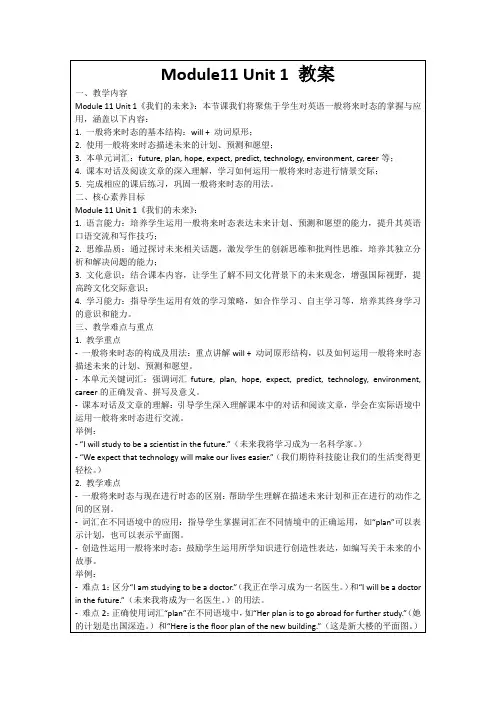
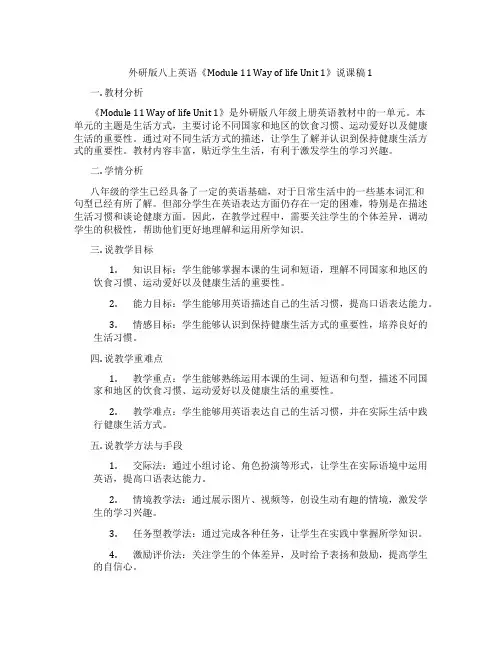
外研版八上英语《Module 11 Way of life Unit 1》说课稿1一. 教材分析《Module 11 Way of life Unit 1》是外研版八年级上册英语教材中的一单元。
本单元的主题是生活方式,主要讨论不同国家和地区的饮食习惯、运动爱好以及健康生活的重要性。
通过对不同生活方式的描述,让学生了解并认识到保持健康生活方式的重要性。
教材内容丰富,贴近学生生活,有利于激发学生的学习兴趣。
二. 学情分析八年级的学生已经具备了一定的英语基础,对于日常生活中的一些基本词汇和句型已经有所了解。
但部分学生在英语表达方面仍存在一定的困难,特别是在描述生活习惯和谈论健康方面。
因此,在教学过程中,需要关注学生的个体差异,调动学生的积极性,帮助他们更好地理解和运用所学知识。
三. 说教学目标1.知识目标:学生能够掌握本课的生词和短语,理解不同国家和地区的饮食习惯、运动爱好以及健康生活的重要性。
2.能力目标:学生能够用英语描述自己的生活习惯,提高口语表达能力。
3.情感目标:学生能够认识到保持健康生活方式的重要性,培养良好的生活习惯。
四. 说教学重难点1.教学重点:学生能够熟练运用本课的生词、短语和句型,描述不同国家和地区的饮食习惯、运动爱好以及健康生活的重要性。
2.教学难点:学生能够用英语表达自己的生活习惯,并在实际生活中践行健康生活方式。
五. 说教学方法与手段1.交际法:通过小组讨论、角色扮演等形式,让学生在实际语境中运用英语,提高口语表达能力。
2.情境教学法:通过展示图片、视频等,创设生动有趣的情境,激发学生的学习兴趣。
3.任务型教学法:通过完成各种任务,让学生在实践中掌握所学知识。
4.激励评价法:关注学生的个体差异,及时给予表扬和鼓励,提高学生的自信心。
六. 说教学过程1.导入:通过展示不同国家和地区的饮食习惯、运动爱好等图片,引导学生谈论生活方式,自然引入本课主题。
2.新课呈现:教师引导学生观察图片,让学生说出图片中的食物、运动等,然后板书新词和短语。
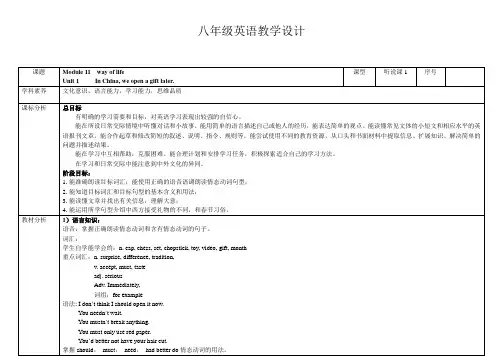
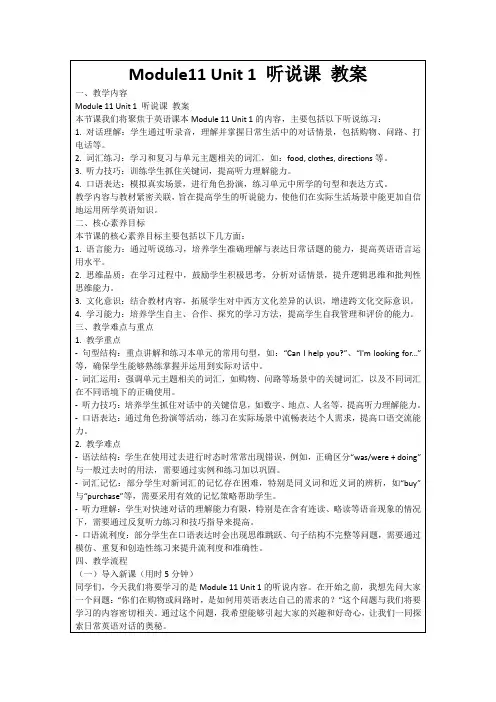

本节课是一节听说课,听说课要以听说为主,兼顾读写。
我们采用“听前说——听中说——听读说——学以致用”的听说课教学模式。
一:课前检查单词
shake hands 握手
smile 微笑
bow 鞠躬
让学生通过图画判断不同国家的问候方式
课前我已让学生在QQ 群里将自己喜爱的动画形象图片及所喜欢动画的主要内容和故事梗概发到群共享中,一上课我就精选同学们的帖子图片进行导入,可以直接激发学生们的学习兴趣。
(以上是学生们发帖较集中的图片)在介绍图片时,重点介绍touch noses kiss hug 这三种问候方式,并将其相关的活动简单介绍,充分利用网络资源调动学生视听感官,激发学生学习欲望和热情。
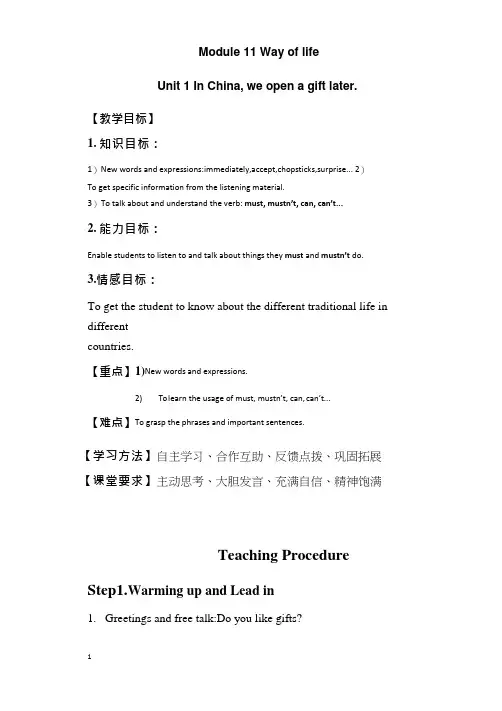
Module 11 Way of lifeUnit 1 In China, we open a gift later. 【教学目标】1.知识目标:1)New words and expressions:immediately,accept,chopsticks,surprise... 2)To get specific information from the listening material.3)To talk about and understand the verb: must, mustn’t, can, can’t...2.能力目标:Enable students to listen to and talk about things they must and mustn’t do.3.情感目标:To get the student to know about the different traditional life in differentcountries.【重点】1)New words and expressions.2) To learn the usage of must, mustn’t, can,can’t...【难点】To grasp the phrases and important sentences.【学习方法】自主学习、合作互助、反馈点拨、巩固拓展【课堂要求】主动思考、大胆发言、充满自信、精神饱满Teaching Procedure Step1.Warming up and Lead in1.Greetings and free talk:Do you like gifts?(并以实物展示为同学们准备的礼物,提高他们参与本节课的积极性)2.Watch a video and answer the questions:(1)What gift does the girl get?(2)Does she open it immediately?Step2.Words and Expressions(听力小热身)1.Words guessing. (以玲玲要过生日了为话题,让同学们猜她会收到什么礼物。
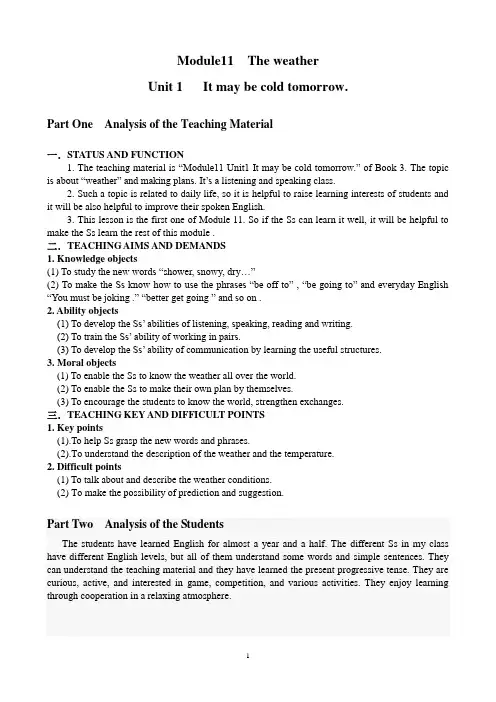
Module11 The weatherUnit 1 It may be cold tomorrow.Part One Analysis of the Teaching Material一.STATUS AND FUNCTION1. The teaching material is “Module11 Unit1 It may be cold tomorrow.” of Book 3. The topic is about “weather” and making plans. It’s a listening and speaking class.2. Such a topic is related to daily life, so it is helpful to raise learning interests of students and it will be also helpful to improve their spoken English.3. This lesson is the first one of Module 11. So if the Ss can learn it well, it will be helpful to make the Ss learn the rest of this module .二.TEACHING AIMS AND DEMANDS1. Knowledge objects(1) To study the new words “shower, snowy, dry…”(2) To make the Ss know how to use the phrases “be off to” , “be going to” and everyday English “You must be joking .”“better get going ” and so on .2. Ability objects(1) To develop the Ss’ abilities of listening, speaking, reading and writing.(2) To train the Ss’ ability of working in pairs.(3) To develop the Ss’ abilit y of communication by learning the useful structures.3. Moral objects(1) To enable the Ss to know the weather all over the world.(2) To enable the Ss to make their own plan by themselves.(3) To encourage the students to know the world, strengthen exchanges.三.TEACHING KEY AND DIFFICULT POINTS1. Key points(1).To help Ss grasp the new words and phrases.(2).To understand the description of the weather and the temperature.2. Difficult points(1) To talk about and describe the weather conditions.(2) To make the possibility of prediction and suggestion.Part Two Analysis of the StudentsThe students have learned English for almost a year and a half. The different Ss in my class have different English levels, but all of them understand some words and simple sentences. They can understand the teaching material and they have learned the present progressive tense. They are curious, active, and interested in game, competition, and various activities. They enjoy learning through cooperation in a relaxing atmosphere.Part Three Teaching Methods and Aids一. Teaching Methods1. Communicative teaching method2. Audio-visual teaching method3. Task-based” teaching methodAs we all know, the main instructional aim of learning English is to cultivate students’ a bilities of listening, speaking, reading, writing. So in this lesson, I’ll mainly use “Communicative” teaching method, “Audio-visual” teaching method and “Task-based” teaching method. That is to say, I’ll let the Ss get a better understanding of the key structure of the dialogue.二. Teaching AidsMulti-media computer, Power point, and blackboard.Part Four Teaching ProceduresStep I Lead-in1. Greeting.2. Flash. (Introduce the content of this module---weather.)T: (after watching a flash about weather) Do you like this flash? What is it about?S: The weather.T: What’s the weather like today? Is it windy?S: …Purpose: Introduce the topic: the weatherStep II Pre-listeningStep 1. Ask questions,What’s the weather like today? Is it warm? Can you eat an ice cream? You must be joking. Purpose:Review all the adjectives that can be used to describe the weather, and show some examples of everyday English.Step 2. Show some pictures, review the symbols about the weather and introduce the possibility: may, might, probably.Can you guess, what will the weather be like tomorrow? Look at the scream and use…It may be…It might be…It’ll probably be…Purpose: Report the weather today, then guess what the weather will be like... In this way, we can use some words and sentences to guess the weather and the temperature. According to this, the Ss can grasp how to express the temperature.Step3. Practice1: According to the pictures, and answer “What do the symbols mean?” Purpose: Review the symbols and add students’ interests of learning and the expression ability.Step4. Practice2: Can you guess, when it is snowy, what’s the temperature?It may be /might be /will probably be…Between and degrees (centigrade)Purpose: Introduce the expression of the temperature.Step III While-listening (Listen and finish the table. Complete Activity2, 3, 4)Step 1. Listen and do Activities2, 3 then check it.Step 2. Teacher: Our friends Daming, Tony, and Betty will travel around the world. Let us listen what they are talking about. (Activity4)Step 3. Do some practice to catch the details.Step 4. Read in role.Purpose: According to these steps, the Ss can catch the main ideas, and then catch the details. Especially, the reading in role is very necessary. It helps to provide the real language environment. What’s more, it can add the Ss’ interest s and help the Ss grasp the knowledge points.Step IV Post-listeningStep1. Language points1. Point out the language points. After that, the students would be instructed to list the clues and recreate the conversation.2. Act the conversation out in groups.Step2. Short playsT: There are two tasks. You could choose the one of them you like to act it out.Task one: A short playAfter watching the weather report around the world, the family are discussing …Character: a weather reporter, dad, mum, a childDiscussion: favorite places to visit, weather, temperature, advice …Task two: A short playTwo people want to go traveling, but their plans are very different. So they are talking about the weather around the world, then the weather report will give them the answer.Character:two weather reporters,two people who want to go traveling around the world. Purpose: According to the tasks, Ss can use the language to describe the weather and give some advise. It makes the teaching aims realized.Step 3.PracticePurpose: To check the knowledge Ss have learned in this lesson.Step 4.Affective education (The background: soft music)T: Yesterday was sunny, today is cloudy, it will probably be rainy. If we couldn’t change the weather, we will change ourselves. To keep a wonderful mood, you may be happy every day.Purpose: Let the Ss know how to love themselves.Step5. Homework1.Make a dialogue with you partner about the weather.2.Make their own plan for the winter holiday.3.Do some exercises on exercise book.Purpose: I think homework is so important that the Ss should speak English as much as they can in class or after class. It is necessary for the Ss to do some exercises after class to consolidate the knowledge they learned.Part Five Blackboard DesignModule11 Unit1It may be cold tomorrow.It may be /might be /will probably be…Between and degrees (centigrade)Purpose: It can help the Ss know the key point clearly.Part Six Teaching EvaluationIn the whole class, in order to attain the request of learning English in junior school, I mainly make kinds of activities between teacher and students, arouse the students' interest in learning English, cultivate a positive attitude towards learning English, put the emotion, attitude and values to achieve the aims of the knowledge and ability. I believe, there is no students who can’t learn English well . Therefore, we should encourage the children and let them know—English, I can!。
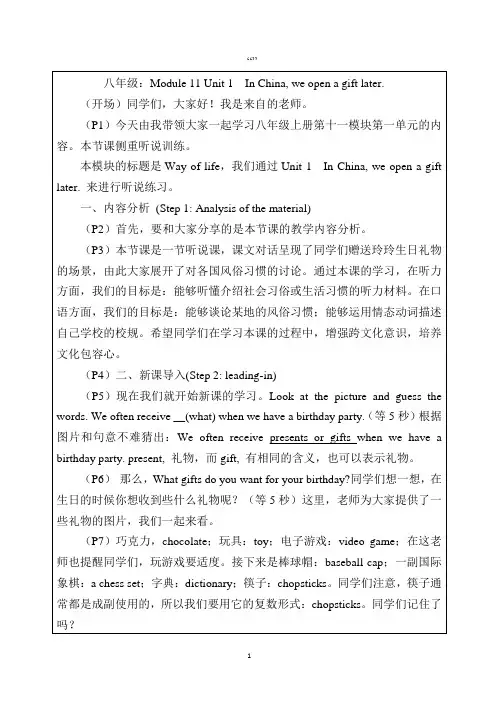
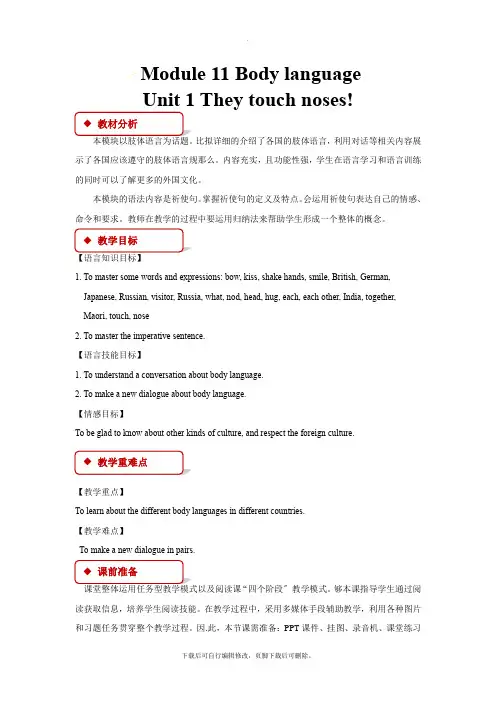
Module 11 Body language Unit 1 They touch noses! 本模块以肢体语言为话题。
比拟详细的介绍了各国的肢体语言,利用对话等相关内容展示了各国应该遵守的肢体语言规那么。
内容充实,且功能性强,学生在语言学习和语言训练的同时可以了解更多的外国文化。
本模块的语法内容是祈使句。
掌握祈使句的定义及特点。
会运用祈使句表达自己的情感、命令和要求。
教师在教学的过程中要运用归纳法来帮助学生形成一个整体的概念。
【语言知识目标】1. To master some words and expressions: bow, kiss, shake hands, smile, British, German, Japanese, Russian, visitor, Russia, what, nod, head, hug, each, each other, India, together, Maori, touch, nose2. To master the imperative sentence.【语言技能目标】1. To understand a conversation about body language.2. To make a new dialogue about body language.【情感目标】To be glad to know about other kinds of culture, and respect the foreign culture.【教学重点】To learn about the different body languages in different countries.【教学难点】To make a new dialogue in pairs.课堂整体运用任务型教学模式以及阅读课“四个阶段〞教学模式。
够本课指导学生通过阅读获取信息,培养学生阅读技能。
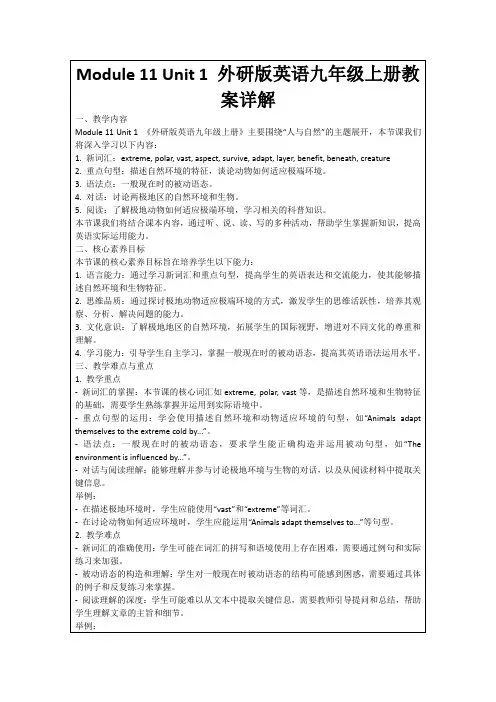

外研版英语七年级下册《Module11 Body language Unit 1》说课稿一. 教材分析外研版英语七年级下册《Module11 Body language Unit 1》的主要内容包括:听力、对话、语法、阅读和写作等部分。
本节课的主要内容是学习身体语言在日常交流中的应用。
通过本节课的学习,学生能够掌握一些基本的身体语言表达,如微笑、点头、摇头等,并能在日常生活中正确运用这些身体语言,提高交际效果。
二. 学情分析根据我对学生的了解,他们在学习过程中对英语充满热情,具备一定的听、说、读、写能力。
但部分学生在理解和运用身体语言方面存在困难,因此,在教学过程中需要关注这部分学生的学习需求,帮助他们更好地掌握和运用所学知识。
三. 说教学目标1.知识目标:学生能够掌握日常生活中常用的身体语言表达,如微笑、点头、摇头等。
2.能力目标:学生能够在日常生活中运用所学身体语言,提高交际效果。
3.情感目标:培养学生对英语学习的兴趣,增强自信心,提高团队合作意识。
四. 说教学重难点1.重点:学生能够正确理解和运用日常生活中常用的身体语言。
2.难点:学生能够在实际交流中灵活运用身体语言,提高交际效果。
五. 说教学方法与手段1.情境教学法:通过设定日常生活中的情境,让学生在实际语境中学习和运用身体语言。
2.任务型教学法:引导学生参与各种实践活动,提高他们在实际交流中运用身体语言的能力。
3.合作学习法:鼓励学生分组讨论、合作完成任务,培养团队合作意识。
4.多媒体教学手段:运用课件、视频等多媒体资源,丰富教学内容,提高学生的学习兴趣。
六. 说教学过程1.导入:通过展示一组图片,让学生猜测图片中人物的心情,引出本节课的主题——身体语言。
2.Presentation:教师讲解日常生活中常用的身体语言,如微笑、点头、摇头等,并通过示范让学生模仿练习。
3.Practice:学生分组进行角色扮演,运用所学身体语言进行交流,教师巡回指导。
模块11 Unit 1 全单元教案(英语周报)Unit 1 Project Writing an essay about careers(译林牛津版高三英语教案教学设计)Teaching aims:Complete the quiz and identifies the skills and interests.Important points & difficult points:Teach them how to write a passage using what they learnt.Teaching Methods:Analyze and use.Teaching Aids:1. The multimedia2. The blackboardTeaching Procedures:Step 1 Lead-in1. What are you interested in?2. What skills do you have?3. What jobs do you think would be suitable for you?Step 2 Part AStep 3 Part B1. What ideas did you have about your career before you did the quiz?2. What did you think about the quiz?3. How did you feel about the result you got?4. Do you think a person could be a mixture of more than one type? Why?5. How accurate do you think the quiz was? Why?6. What else can you do to find the most suitable career for you?7. Do you need advice from your teachers, parents or friends?Why or why not?8. How will you organize and plan the information in your essay?Homework:1. Review new words and expressions in this unit.2. Finish the exercises in Workboo.。
外研版八年级英语上册《Module 11 Way of life Unit 1》说课稿一. 教材分析外研版八年级英语上册《Module 11 Way of life Unit 1》主要介绍了一种健康的生活方式。
本节课的主要内容是让学生们了解和掌握如何保持健康的生活方式,包括合理的饮食、适量的运动、良好的作息时间等。
通过学习本节课,学生们能够提高自己的英语水平,同时也能够了解到如何保持健康的生活方式,这对他们的成长和发展非常有帮助。
二. 学情分析根据我对学生的了解,他们已经掌握了一定的英语基础知识,能够听懂并运用一些基本的英语句子。
但是,他们的英语听说能力和阅读写作能力还有待提高。
此外,学生们对于如何保持健康的生活方式可能了解不多,因此需要通过本节课的学习来提高他们的认识。
三. 说教学目标1.知识目标:让学生掌握如何保持健康的生活方式的英语表达方式,包括合理的饮食、适量的运动、良好的作息时间等。
2.能力目标:通过听力、口语、阅读和写作的练习,提高学生的英语听说读写能力。
3.情感目标:让学生认识到保持健康的生活方式的重要性,培养他们良好的生活习惯。
四. 说教学重难点1.重点:让学生掌握如何保持健康的生活方式的英语表达方式。
2.难点:如何让学生能够将这些表达方式运用到实际的交流中,提高他们的英语实际应用能力。
五. 说教学方法与手段在本节课的教学过程中,我将采用任务型教学法,让学生在完成任务的过程中学习和掌握知识。
同时,我会利用多媒体教学手段,如PPT、视频等,来帮助学生更好地理解和掌握知识。
六. 说教学过程1.导入:通过一个关于健康生活方式的短视频,激发学生的兴趣,引出本节课的主题。
2.新课呈现:通过PPT展示本节课的主要内容,让学生初步了解如何保持健康的生活方式。
3.课堂讨论:让学生分小组讨论如何保持健康的生活方式,并鼓励他们用英语表达自己的观点。
4.听力练习:让学生听一段关于健康生活方式的对话,并回答相关问题。
Module11说课稿一、说教学理念英语新课程标准要求教师从教学的实践者转为教学的研究者,活动的组织者,学习的帮助者。
在教学中,通过任务型活计的设计,让学生在学习中体会与运用,在体验中学习与积累。
在提高学生技能,技巧的同时,体验到学习的快乐,从而乐学、愿学,主动参与到任务活动中去。
并且陶冶学生的情操,树立正确,乐观的人生观、世界观。
二、说教材教材概述:我说课的内容是外研版新标准英语初一下Module11的第一课时。
本单元的中心话题是谈天气,围绕天气展示听、说、读、写的活动,使学生掌握描述天气的基本词汇及对天气的提问,学会准确表达对某种天气的喜好并说明原因,学会做天气预报,学会叙述在不同的天气背景下做什么。
通过以上活动,使学生能够在实践中体会到学习英语的乐趣,更积极地运用目标语言,培养学生在实际生活中综合运用的学习能力。
三、三维目标的设立1、知识与技能目标。
a、知识目标。
学习表述天气的单词;sunny windy cloudy rain 等及问答天气句型“How’s the weather ”“what’s the weatherlike ?”“ It’s cloudy.”b、能力目标。
①通过学习,学生能够掌握本节出现的表示天气的形容词,及问答天气的句型。
②通过丰富多彩的课堂生活和创造性任务。
把学生所学的目标语言和实际结合起来,培养学生自主学习英语的能力,解决问题的能力,交流合作的能力,并拓展学生的创新空间。
2、过程与方法目标。
以体验学习为主。
以一段“中央电视台天气预报”的视频引入,创设情境使学生身临其境,自然引入天气话题。
教师采用设计问题。
学生提出及解决问题,借助多媒体课件的方式提高学习的积极性。
3、情感态度价值观目标。
(1)通过实践让学生体验在生活中运用英语的快乐,并通过小组活动交流彼此的观点,培养学生互动合作,互相学习的团队精神。
(2)教育学生善于观察,善于描述周围的事物,体会生活的美好,培养学生积极向上的人生态度。
Module 11 Unit 1说课稿Hello, everyone. Today I’m very pleased to have an opportunity to talk about some of my teaching ideas. My topic is “It may be cold tomorrow.” taken from Unit 1 of Module 11. It is made up of six parts.The analysis of the teaching material:The main topic of this module is “the weather”. As we all know, many foreigners begin their conversation with a short talk about the weather. So this module gives us a good opportunity to learn and practice our oral English. In this lesson we will mainly practice listening and speaking in order to enhance the ability of expressing ourselves and communicating with the others. Analysis of the Ss:1. The Ss have learnt some expressions of describing the weather. But they seldom use English to express it and communicate with the others.2. Some Ss are not active in the class because they are shy or some of them are afraid of making mistakes.So in the class we should focus on raising their interests of English, encouraging them to speak English bravely and teaching them to cooperate in groups.Teaching aims:According to the teaching material and the condition of the students, the teaching aims of this lesson are divided into three parts.1. Knowledge aims(1) To make the Ss learn some more expressions of describing the weather.(2) To learn how to use the words “may, might, must, probably” properly by learning the dialogue of this lesson.2. Ability aims(1) To develop the students’ abilities of listening and speaking.(2) To develop the Ss’ abilities of communication by learning the useful structures.3. Moral aimsRaise their interests of English, work in groups and learn to cooperate with others.The important points of this lesson are practicing the ability of listening and speaking and learning the usage of the important words in this unit: may, might, must and probably.The difficult points of this lesson are to encourage the students to speak English bravely and enable the Ss to study in groups and co-operate skillfully.Teaching theories, methods and aidsAs we all know: the main instructional aim of learning English in the Middle School is to cultivate students’ abilities of listening, speaking, reading, writing and their good sense of English. Before deal ing with this lesson, I’ll do my best to carry out the following theories: Make the Ss the real masters in class while the teacher acts as director;Combine the language structures with the language functions; Let the students receive some moral education while they are learning English.Teaching method:Question-and-answer activity teaching methodWatch-and-listen activityFree discussion methodPair work and individual work methodCommunicative teaching methodAudio-visual teaching methodTask-based teaching method教学过程:。
The main part of this lesson will be the teaching process. There are three parts in this lesson. Now I will explain them one by one.【课前延伸】Before class I will ask the students to preview the new words and check in pairs. At the very beginning of this lesson, the students should read the new words together and then a student should give our daily report. Say something about today’s weather will be a good choice.【课内探究】I will finish the second part in four steps:The first step is warm-up. First, the students should check their new words in groups. Then we will have a free talk. We can use some information of the daily report. Such as: What’s the weather like today? Is it cold? What’s the temperature today? Then we will talk about the weather of tomorrow. So we can practice the general future tense, which can prepare for the listening practice. Here the students should pay attention to the role of changing the nouns into adjectives.(二)The second step is listening. Listen to the weather forecast and check the correct information in the table of Activity 2.(三)The third step is dealing with the dialogue.Guessing game: The New Y ear is coming. Let’s guess what the weather will be l ike on that day in Weifang. Do you want to know the weather in other cities? We can use these sentences. 1). --What will the weather be like on January 1st in Weifang?--It may/might/will probably be…2). --What will the weather be like in …?--It may/might/will probably be…Ask the students to practice with their deskmates, so we can get a general idea of may/ might/ probably.1、1). Listen and choose the correct answer.①. It may be wet/ dry in England.②. It will probably be cloudy/ sunny in Australia.③. It may be quite warm/ cool in Hong Kong.2). Listen and check T/F.①.There’ll sometimes be snow in winter in England.②.It’s often freezing in February in England.③.It’s usually hot in February in Australia.④.It’s always too hot in the USA.Ask the students to close their books and listen to the tape. Listen for the first time and choose the correct answer and then listen again and check the information T/F. After listening for twice, the students can get the main information of this dialogue. During the listening, I will teach them some skills of listening.2、After listening, I will ask the students to read the dialogue carefully in silent and complete the table in Activity 5. So they can get more detail information.3、Read the dialogue in groups and find out some difficult language points._________________________________________________________________________________________________________________2). must, may, might, probablymay be & maybebe off to3). Complete the sentences with may/ must/ probably/may be/ maybe.①. It will ___________ rain tomorrow.②. Mary ______go to England next month.③. He is late for school again, the teacher ______be angry.④. ________you can ask Tony for help.⑤. He ________in the office.In this part the students should learn the dialogue by themselves and find out the points that they can’t understand. Then they can discuss their problems in their groups. If they can’t deal with all the questions, they can ask other groups for help. At last they should show their questions to the teacher. I’ll mainly explain three points besides their questions. They are the u sage of must, may, might, probably; the difference between may be and maybe; be off to. Then I’ll give them some exercises to deepen their impression.4、Read the dialogue in roles. In this part they should read loudly and pay attention to their pronunciation and intonation.5、A: What are you doing?All: ____Lingling’s present.A: ____ Spring Festival?Tony: _______England. It______wet and windy there.A: ________the USA?Betty: ____Australia.A: ____weather ___?Betty: ______hot and sunny.A:________,Daming?Daming: _____ Hong Kong. It ____cool, but ____dry.Use the given information and try to retell the dialogue in groups. We can check if they have mastered this dialogue well from the exercises and the retelling work.(四)学以致用What’s the name of the city?What will the weather be like?What can you see/ eat/ enjoy there?The last step is to use the learned knowledge in our daily life. The winter holiday is coming. Many students may want to go for a travel. Every group will describe a city. They can introduce the weather, some places of interest and so on. Then each group should have a spokesman as the guide to show their work. And at last we will choose the best guide and the best group.【课后提升】After class the students should master the new words and expressions and can use them perfectly. Act as a reporter of the weather forecast in your group to give a report of the weather in the main cities of China. (选作)Get some information about the weather of some American cities to prepare for the next lesson.。